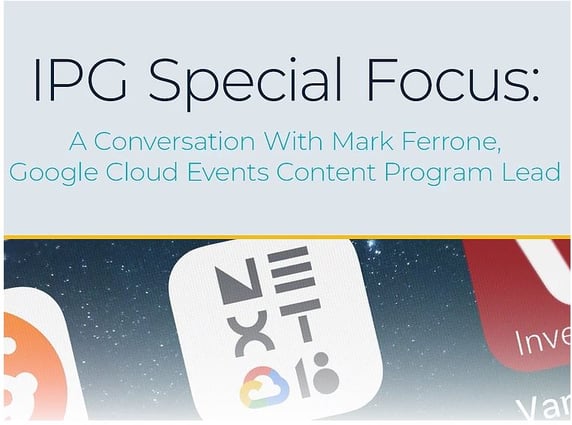In our most recent Digital Event Forecast we had the opportunity to connect with Mark Ferrone, Google Cloud Event Content Program Lead, to gather first-hand insights and reflections on tackling the audacious task of creating a novel multi-week digital conference experience.
In March 2020, the Google Cloud Next team announced that their three-day event, originally scheduled to take place in-person in San Francisco in April, would be postponed. In July 2020, the team delivered a completely reimagined Google Cloud Next OnAir experience, a content-rich, engaging and interactive nine-week digital event series.

Erica Spoor, IPG: What was the main objective in your event design—prerecorded, on-demand, with a nine-week content release schedule?
Mark Ferrone, Google: Our main objective was to drive demand generation, enrichment, education and engagement with new and existing customers.
Spoor: Which types of content or nine-week themes were the most successful and why?
Ferrone: We tracked the overall success of specific content based on people viewing greater than 80% of a given video asset. Several different types of content consistently performed well, including executive keynotes, industry keynotes, weekly solution keynotes, demos and breakouts that featured customers or were related to new product announcements.
We think these were most successful because our customers and partners were expecting updates from Google Cloud on the respective theme areas. Some of these session types did also receive more social media support than others, which contributes to higher view rates. We also saw consistently higher viewership and retention for shorter sessions, i.e. those under 15 minutes in total duration.
Spoor: What are the bigger challenges your team is grappling with right now?
Ferrone: The team is now working on discovering how to further surprise and delight our users, absorbing learnings and feedback to implement in future digital events. Like our industry peers, we’re diving into 2021, planning with an eye on what a live event experience should look like and how digital events can be more personal and drive more community engagement. In addition, the team continues to focus on personal well-being, given the growing pressures of new” always-on digital conference programming in a highly competitive enterprise IT sales environment.
_____________________________________
Spoor: What new learnings came out of this experience for your event team? How will the experience change your long-term strategies or philosophies?
Ferrone: There were many new learnings and insights that came out of this effort. First and foremost, digital fatigue is real. Attendees are looking for more opportunities to interact with each other, network and exchange best practices. Executive audiences seem to be more available to attend digital experiences and more likely to engage in virtual round-tables on compelling themes that are moderated by notable speakers or that include notable peers.
Having a web/digital team that is agile allowed us to quickly adjust features to user feedback in real-time. This helped increase engagement and visibility for program elements. We also found that digital demos successfully drive engagement and provide a simplified way to communicate a specific tip, trick or how-to. These assets provided a break from the ‘sit and watch’ nature of breakout or keynote video content. Our digital team successfully created a fluid video production supply chain (and schedule) that was able to feed a multi-week digital conference, in part by unifying video vendor partners behind a single vision. We recognized that it takes time for subject-matter experts and executives, who are regular speakers at physical events, to adapt to digital-first, broadcast-style, on-camera speaking approaches and techniques. More cycles will help improve appetites for more broadcast-style formats.
Another insight was that shorter on-demand content formats (less than 15 minutes), bolstered by social media promotions, perform better. Live scheduled content formats need the support of aggressive communications and social media efforts to compete with viewers’ alternative choices.
And, lastly, team well-being is critically important. Digital requires as much, if not more, production rigor as a physical event. Furthermore, the number of people required to produce high-quality digital content, all of whom are being coordinated while being off-site, requires time, care and a delicate approach.
Spoor: What are your thoughts on how this sentinel moment will impact the industry as a whole and what do you see for the future of digital events?
Ferrone: Attendee expectations are growing, coupled with more choices for digital engagement. In the months to come, we expect smaller and focused events targeting specific audiences. The events would feature a blend of experiences, from traditional on-demand content that people can watch on their own schedule, to live engagements at specific times.
Community building will continue to be critically important. Whilst appropriate at the time, we don’t anticipate featuring a conference show over a multi-week period again in the foreseeable future. This has influenced our thinking for an ‘always-on’ evergreen event series which was reflected in the consistently strong engagement level in the content over the nine-week Next OnAir program, combined with strong repeat attendance.


